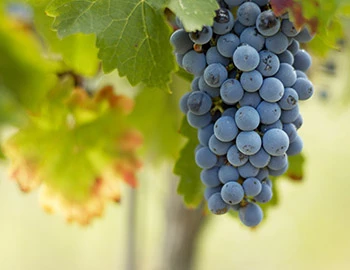
Château Grand-Puy-Ducasse 2019
AC Pauillac 5ème Cru classé, 750 ml

Description
Dense purple colour together with an impressive demonstration of blackcurrants, liquorice, forest floor and graphite. Medium to full body, a powerful personality, lots of pure, sweet fruit with a tantalising texture, a long finish and supple tannins.
Attributes
| Origin: | France / Bordeaux / Pauillac |
| Grape variety: | Cabernet Sauvignon, Merlot |
| Ripening potential: | 5 to 12 years |
| Drinking temperature: | 16 to 18 °C |
| Food Pairing: | Spiced grillades, Saddle of lamb fillet with herb jus, Châteaubriand, Filet Wellington, Wild boar entrecôte with Spätzli, Blue cheese, Spicy hard cheese |
| Vinification: | long must fermentation, fermentation in steel tank, fining |
| Maturation: | in partly new and used barriques/ Pièces |
| Bottling: | filtration |
| Maturation duration: | 18 months |
| Volume: | 13.5 % |
| Note: | Contains sulphites |
Merlot
Everybody’s darling
Merlot is the most charming member of the Bordeaux family. It shines with rich colour, fragrant fullness, velvety tannins and sweet, plummy fruit. It even makes itself easy for the vintner, as it matures without issue in cool years as well. This is in contrast to the stricter Cabernet Sauvignon, which it complements as a blending partner. Its good qualities have made the Merlot famous worldwide. At over 100,000 hectares, it is the most-planted grape in France. It also covers large areas in California, Italy, Australia and recently in Eastern Europe. The only catch is that pure Merlot varieties rarely turn out well. Its charm is often associated with a lack of substance. Only the best specimens improve with maturity. They then develop complex notes of leather and truffles. This succeeds in the top wines from the Bordeaux appellation of Pomerol and those from Ticino, among others.

Pauillac
Pauillac: Aristocratic crus
No appellation embodies the noble Bordeaux virtues on such a fine, almost majestic level as Pauillac, the peninsula resting in the Médoc. With Lafite-Rothschild, Latour and Mouton-Rothschild, it is also home to the majority of the five premier crus. The grandeur of Pauillac crus is quite clearly based on the Cabernet Sauvignon variety, which, with a share of over 70 percent, certainly dominates in assemblages, and also lends the wines excellent aging potential.

Bordeaux
Bordeaux: high prestige, high quality
With a total area of around 115,000 hectares, Bordeaux may not be France’s largest wine-growing region, but it is certainly its most prestigious. The range of wines produced here today is enormous: ranging from red everyday wines with a great relationship between price and quality to exclusive, and accordingly expensive, premier crus. Elegant white wines and noble sweet specialties round out the spectrum.

France
France – Philosophy in a bottle
According to French philosophy, wine should be an expression of the soil and climate. They use the word “terroir” to describe this. Terroir makes every wine different, and many especially good. French wine is regarded worldwide as an expression of cultural perfection. The French believe that humans are responsible for the quality of the berries, the vine variety for their character, and nature for the quantity. This philosophy can be expressed succinctly as: “the truth is the vineyard, not the man.”


